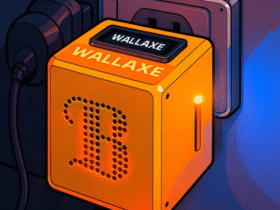Iván Paz Chain does not agree that the 4-year cycles for bitcoin are over.
Being profitable in trading is possible, but only with good preparation and adequate tools.
Bitcoin (BTC) and cryptocurrency trading is a minefield of myths, unrealistic expectations, and rapidly changing narratives.
In the midst of the excitement of LABITCONF 2025, held in Buenos Aires, CriptoNoticias spoke with Iván Paz Chain, director and founder of Trading Different, to unravel What is true in the idea of ”living from trading”whether the four-year cycle has expired, and how artificial intelligence is shaping the future of investing.
With three consecutive years participating as a speaker at the event, Paz Chain has become a reference voice in quantitative market analysis. His vision, far from excessive optimism and anchored in dataoffers a sober perspective on the dynamics of bitcoin.
The dialogue goes through his own discovery of Bitcoin, the creation of his analysis tools and his diagnosis of the current market moment, where he warns that, although the technology remains robust, the price faces clear signs of exhaustion.


You have to “live bitcoin” to understand it
Like many in the ecosystem, Iván Paz Chain’s relationship with the digital currency did not begin in trading, but in curiosity. “Back in 2015 I was starting to talk to maybe some of my first friends about bitcoin,” he remembers. Initial uncertainty gave way to action: “Very fearfully, I bought my first bitcoins, I did some mining at that time.”
However, he highlights that the real understanding of the protocol did not come just by reading the White Paper, but through experience. “I think that even though one studied the entire theory of Bitcoin at that time, in reality you end up understanding Bitcoin over the years, when you live Bitcoin,” says Paz Chain.
What does it mean to “live Bitcoin”? For the analyst, it is when theory faces the practice of real needs.
“Living bitcoin means starting to value its properties around the fact that life is giving you certain challenges where bitcoin solves them, such as, for example, the reserve of value, which is unconfiscatable, which gives you the freedom to transfer it wherever you want.”
Iván Paz Chain, director of Trading Different.
That life experience soon intersected with market volatility. Paz Chain bought his first bitcoin at $280 and witnessed the parabolic rise to $20,000 in 2017. “I think at that very moment you think, which happens to most, ‘it’s going to keep going up.’ And no, however, from there a fairly strong decline began.
That fall, first to 6,000 and then to 3,000 dollars, was his true school. “At that moment one understands that the market has cycles, that everything that is price, one has to study, one has to understand who the main market players are,” he reflects. The objective: “know when to invest heavily” in the floors and take profits “when the price is very high.”
The art of knowing when to sell
«What is more difficult? Know when to buy or when to sell? I ask the specialist who immediately answers me: “when to sell, without a doubt.”
Explain that Identifying market floors, although difficult, is more feasible. «We believe that we are specialists in identifying the bottom of bitcoin. […] In fact, we have done it in the last dipbelow $16,000, not only me, but my entire community was investing very heavily.
The difficulty of the sale, according to his analysis, lies in the lack of references and the complexity of the variables at play.. «They increase the number of variables, how the different whales, the different participants, take profits. […] At a statistical level, normally there is no empirical evidence behind ceilings, that is, there is not enough statistical data to be able to draw conclusions about behavioral patterns.
Is the price of bitcoin manipulated?
The need to understand who moves the price was the genesis of Trading Different, the firm he directs. “It was born as a need of our own, where we sought to better understand the market, to understand why it moved 365 days a year, 24 hours a day,” he comments.
This research led to understanding one of the most recurring questions in the ecosystem: Is the price of bitcoin manipulated? Paz Chain’s response is nuanced. In the macro view, he assures that no. «I don’t think the price itself is manipulated. […] In charts of one day, one week, I do not see the price being manipulated, I think it is respecting very well what determines supply and demand.
However, the story is different in short periods, where retail investors operate. “80% of the time there are not people or entities moving the price of bitcoin,” he explains, but rather high-frequency bots. «At those types of scales, yes, the price is manipulated, look for liquidity. Manipulated in quotes, right? Because it is actually free supply and demand. “They are making purchases in one direction or another to absorb liquidity.”


The 4-year cycle of bitcoin and the ETF factor
The conversation inevitably turns to the big macro topic: the 4-year cycle. With the entry of spot bitcoin ETFs in the United States, Many analysts have decreed the end of the cycles marked by the halving. Iván Paz Chain does not agree.
First, dismantles the idea that ETFs are an unconditional support for the price. “ETFs, just as they have been producing buying pressure on the price, are not interested in holding bitcoin in the long term, they are not holders,” he warns. “What they are looking for is profitability in dollars, which, in times of uncertainty, will translate as selling pressure, not as real support for the price, as many think.”
Second, defends the validity of the price cycle commanded by the halving. Although the reduction in the issuance of new bitcoin is increasingly smaller in relative terms, Paz Chain introduces the other variable to the equation: demand.
«There is a lot of talk about the fact that every time the halving […] “It has less influence on the price,” he concedes. «But, based on that, what people do not consider is that the adoption of bitcoin is also increasing, that is, that demand is absorbing more BTC. Therefore, that small supply that is being reduced in the market is having an influence and will still have it, I think at least for one more cycle.
With that premise, his vision for the near future is cautious. Asked if we can expect a bearish 2026, he answers affirmatively.. “Yes, I think […] the price is facing selling pressure, resistance around 110 to 130 [mil dólares]. […] I think that, possibly, at least the data says so, we will have a bearish 2026.
Paz Chain insists that, although the bullish cycle “may still have one more attempt to search for a maximum zone,” the data suggests that the probability of a reversal is greater. “It is natural, it is normal that prices tend to seek equilibrium” after such a vertical rise from 15,200 to 126,000 dollars. His maxim is clear: “Since we have no certainty about what the price is going to do, no one does, it is simply reacting to the data.”
Is it possible to make a living from trading?
The director of Trading Different also addresses one of the biggest myths surrounding the market: the idea of financial independence through trading. «Is it possible to make a living from trading? “Is it a fantasy?” we asked.
“There is a lot of fantasy in the middle, yes, without a doubt,” he answers bluntly.
«People usually look for easy and quick results, which as a trader they will never find. Yes or yes, to be a profitable trader, one needs experience in the market.
Iván Paz Chain, director of Trading Different.
Paz Chain defines the yardstick to measure profitability: track record. “The only way to demonstrate that you are a profitable trader is with a track record,” and he clarifies that “one or two years is not enough. […] Minimally, 2 years or more because it precisely has to go through different stages of market behavior.
On that path, the biggest obstacle is the mind. “No person likes to lose, no person is even prepared to lose,” he points out. The solution that he proposes to nullify the emotional factor is quantitative trading.
«There is a way to reduce that interference [psicológica] in the trader,” he explains. “Define clear, mathematical, quantifiable premises, which can even be reproduced by a bot, and operate in a certain way as if we were a machine, trying to leave aside the discretion of the analysis.”
The future: artificial intelligence, caution and bitcoin
Speaking of operating like machines, the emergence of artificial intelligence (AI) raises questions about the future of the human analyst. Paz Chain believes that the manual trader will not disappear.
“I believe that it will continue to exist because there is a type of trading that is discretionary, and the analyst of news or first-hand information or other types of patterns that can make it a little difficult for an AI to detect.”
However, he warns about the risks of blindly trusting new technologies. «Be very careful, very careful with those who think that they can put together a strategy or a trading bot with artificial intelligence where it does not make even the slightest difference. backtest 4 years back from the price.
Finally, Iván Paz Chain offers advice to the CriptoNoticias audience, separating investment from professional speculation.
«First of all, be willing in this world of investments to face losses. […] “Don’t go crazy, don’t risk more than you are willing to lose,” he advises.
And he concludes by differentiating the difficult path from the simple path: «If you don’t want to complicate things [con] trading, which has to be taken as a profession as it is, you have to study and have a lot of experience […]”Just dedicate yourself to investing in bitcoin, holding bitcoin and only bitcoin.”






Leave a Reply